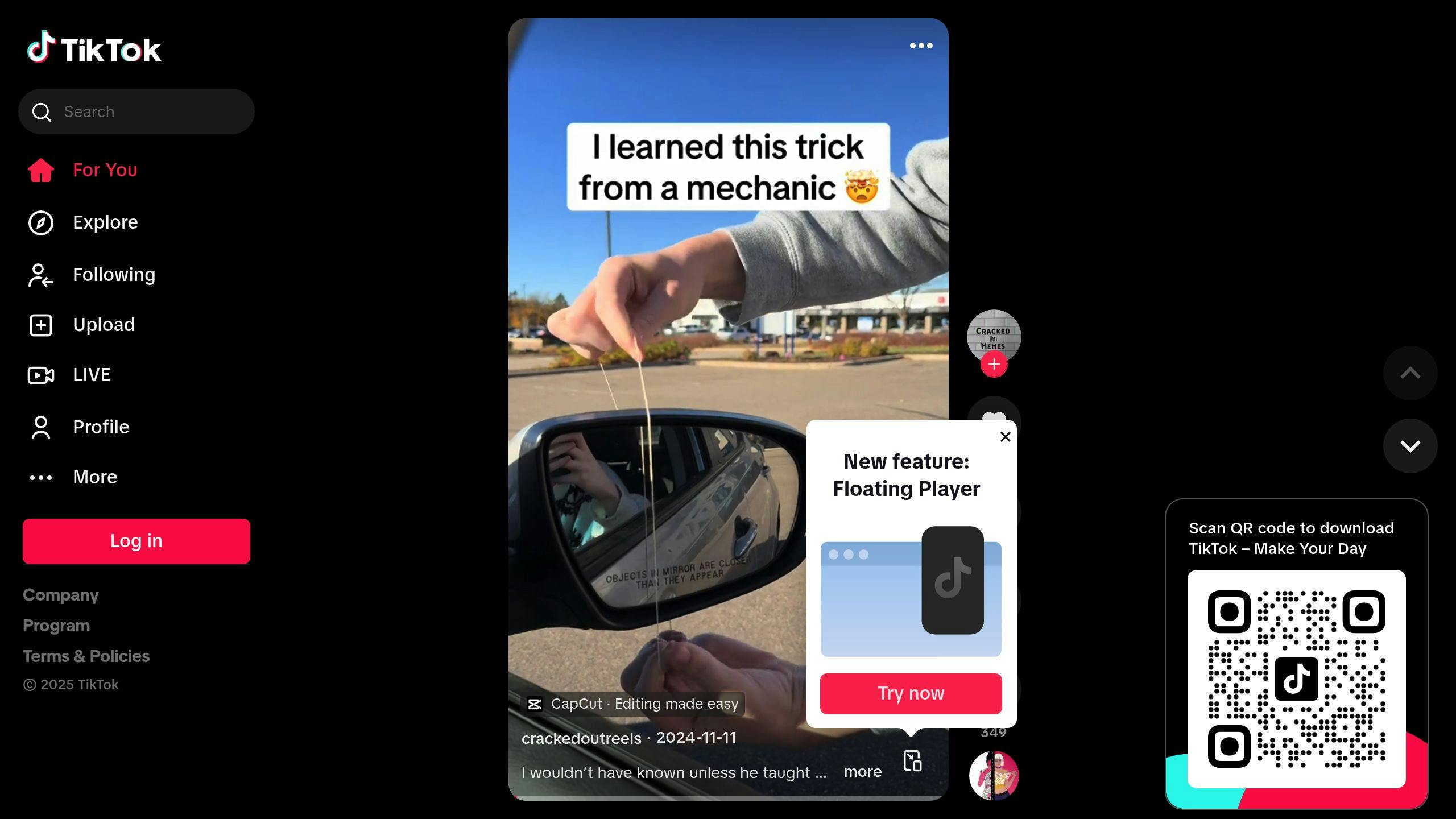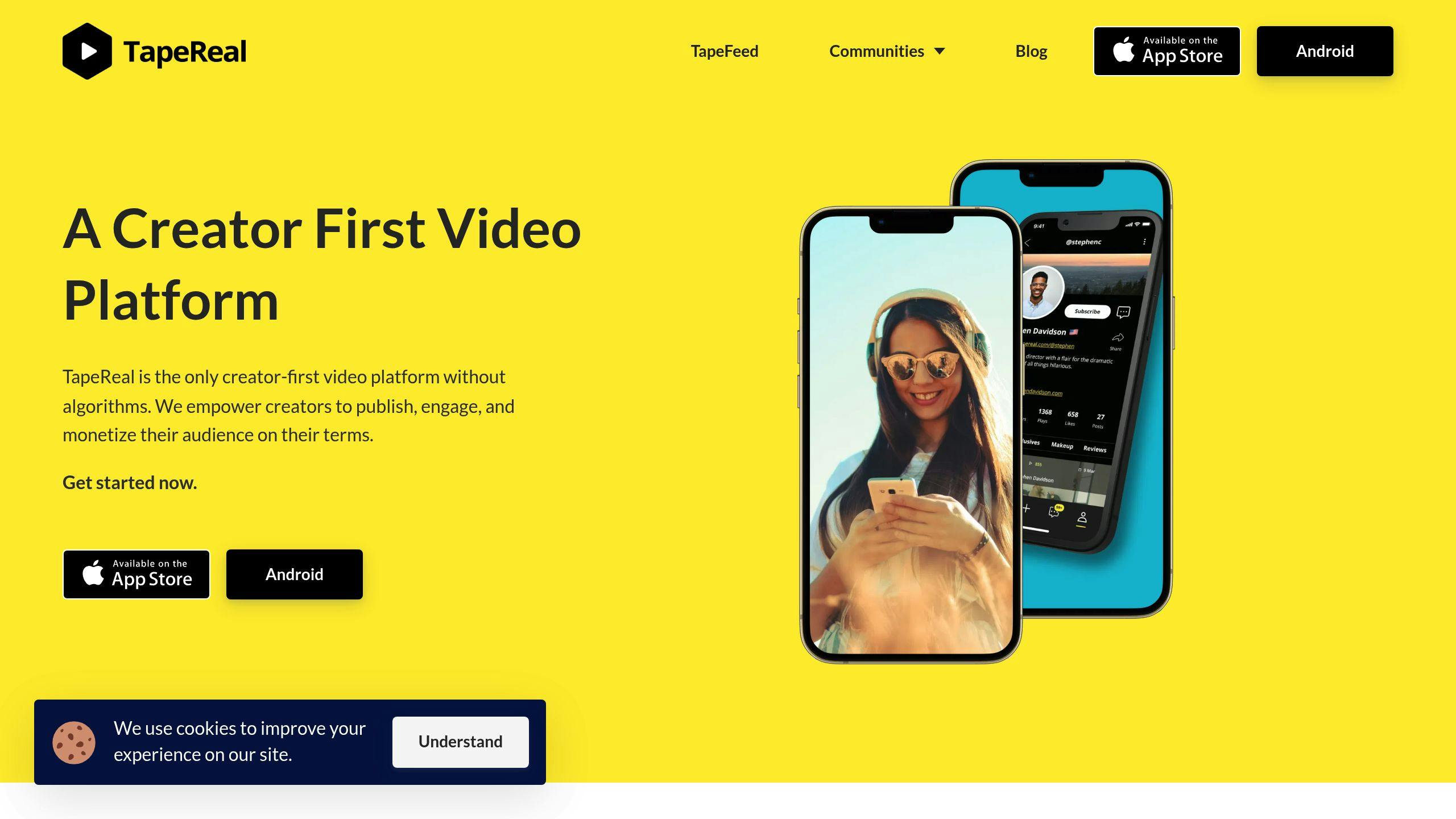The potential TikTok ban in the US could disrupt the livelihoods of millions of creators and businesses. If ByteDance doesn’t sell TikTok to a US-based company by February 9, 2025, creators may lose access to the platform. Here’s what you can do now to prepare:
- Diversify Platforms: Start building a presence on alternatives like Instagram Reels, YouTube Shorts, and emerging platforms like TapeReal.
- Strengthen Audience Connections: Build direct relationships through email lists or community platforms to maintain access to your followers.
- Expand Revenue Streams: Explore options beyond TikTok, such as brand deals, paid newsletters, and selling exclusive content.
- Tailor Content for Each Platform: Adjust your content format and style to match the requirements and audience preferences of different platforms.
Quick Tip: Creators who diversify across three or more platforms see 38% higher income stability during platform shifts. Act now to safeguard your audience and income!
How to Prepare for the TikTok Ban

How the TikTok Ban Affects Creators
The TikTok ban has created serious challenges for content creators who rely on the platform for their livelihoods. Let’s break down how this impacts their work and income.
Main Challenges
The ban disrupts much more than just access to TikTok. Creators are seeing their workflows and earnings take a hit. For instance, other platforms offer creators 30-50% less in earnings compared to TikTok [5].
Here’s how the financial impact breaks down:
| Revenue Stream | Impact |
|---|---|
| In-app Monetization | Loss of $50-$500 per month from tips and tokens [5] |
| Brand Partnerships | 45% fewer short-form sponsorship deals [6] |
| Content Production | Extra 15-20 hours weekly for reformatting content for multiple platforms [8] |
Creators are also facing technical challenges. Sarah Muzzy, a creator, shared that producing content for other platforms can take 2-3 times longer due to their editing requirements [1]. Despite the extra effort, there’s no guarantee they’ll maintain their current engagement levels.
Most Impacted Creator Groups
Some creators are feeling the effects more than others. Here are the groups facing the biggest risks:
- New creators (0-2 years of experience): Those who rely solely on TikTok are particularly vulnerable. Natalia Hauser (Trinity '24) explains that creators transitioning to other platforms could lose 60-80% of their reach because they have to rebuild their audience without TikTok’s discovery algorithm [1].
- Part-time creators: Many, like students, depend on TikTok for extra income. A survey found that 38% of these creators are considering quitting content creation entirely [1].
- Established creators: Even seasoned creators are feeling the strain. Jen White (@.jenwhite), based in Chicago, expects her income to drop by 75% without TikTok’s partnership programs [5]. To counteract this, she’s ramped up her Instagram Reels production by 300% since January 2025 [5].
Some creators are already trying new ways to make money. For example, lifestyle creator Natalia Hauser has shifted to paid newsletters, charging $8 per month for subscriptions [1]. This shows how important it is for creators to find income streams that don’t depend on a single platform.
The uneven effects of the TikTok ban highlight the importance of diversifying platforms and building direct connections with audiences - topics we’ll dive into next.
Moving to Other Platforms
To deal with algorithm changes and income declines, creators need to expand their presence across multiple platforms thoughtfully.
Top Short Video Platforms
With TikTok's future up in the air, creators should explore other platforms to maintain their reach. Here's a breakdown of some popular options and their monetization methods:
| Platform | Monetization Options |
|---|---|
| YouTube Shorts | Partner Program ad revenue |
| Instagram Reels | Brand partnerships |
| Triller | Brand deal marketplace |
| Likee | Regional sponsorships |
| Clapper | Direct sponsorships |
TapeReal: Platform Features

While the big platforms offer reach, newer platforms like TapeReal give creators more control over their earnings and audience. This aligns with the idea of building revenue streams that don't rely entirely on platform algorithms.
TapeReal stands out with features like:
- A marketplace for selling exclusive content (think early releases or premium tutorials).
- Tools for building niche communities and tracking engagement.
- Advanced analytics and monetization options for creators.
TapeReal also offers community feeds, where creators can create spaces for focused discussions with their audience.
"The key is maintaining that nurturing environment you had on TikTok through active comment engagement on your new platform" - Katie Xu (@katiexsocials) [1]
These tools are designed to help creators tackle the income challenges many face today.
Using Content Across Platforms
Once creators choose alternative platforms, they need to tailor their content to fit each one. With challenges like the TikTok ban, this process involves both technical tweaks and strategic shifts. Here's a quick breakdown of platform-specific requirements:
| Platform | Format Requirements | Content Style |
|---|---|---|
| Instagram Reels | 9:16 ratio, 90-sec max | Visually consistent, uses trending audio |
| YouTube Shorts | 1:1 or 4:5 ratio, 60-sec max | Clear, searchable titles |
| Flexible ratio | Minimal Gen Z slang, more context | |
| Professional format | Business-oriented content |
These adjustments are just the starting point. Tools like CapCut or Canva can simplify the process of reformatting content. However, avoid directly cross-posting the same content across platforms - this can reduce engagement by up to 60% [9].
Content Type Changes
One effective approach is to repackage short-form content into various formats to reach a wider audience. Creators like Sarah Muzzy (@sarahmpov) have successfully used this method:
"By strategically using trending sounds in my Reels with modified hooks, I grew my Instagram following by 40%" [1].
Here are some ways to transform content:
Video to Text Conversion
- Turn video transcripts into carousel posts
- Extract snippets for newsletters
- Expand scripts into full blog articles
Long-Form Adaptations
When creating longer YouTube videos, add at least 20% new footage to avoid duplicate content penalties [5].
Using this multi-format strategy not only helps widen your reach but also ties into income diversification goals. To measure success, make use of analytics tools to track metrics like engagement rates and watch time.
sbb-itb-bc761f5
Building Your Own Audience List
Expanding across multiple platforms can help you reach new people, but having direct access to your audience ensures long-term stability. Data reveals that creators who manage their own audience lists retain 85% more followers when switching platforms [6]. This supports Professor Subrahmanian's advice on staying proactive with audience management.
Growing Your Email List
An email list is one of the most reliable ways to stay connected with your audience. Tools like Kit make it simple to create landing pages that turn social media followers into subscribers [4]. Consistency is key - irregular email schedules can lead to a 67% drop in subscriber retention [4].
Here’s how creators successfully attract subscribers:
| Method | Conversion Rate | Ideal For |
|---|---|---|
| Free Lead Magnets | 15-25% | Tutorial creators |
| Early Access Content | 30-40% | Product reviewers |
| Exclusive Updates | 20-35% | Lifestyle content |
| Community Access | 25-45% | Educational creators |
Monetizing with Paid Content
After building a solid subscriber base, you can introduce paid content options to generate revenue:
- $5-15/month: Exclusive updates
- $25-50/month: Live sessions
- Annual plans: Offer a 20% discount to boost retention by 62% [10]
Allison Chen (@al.chenny) shares how this approach has worked for her:
"By transitioning my baking tutorials to a premium model through direct email promotions, I now generate 40% of my income from PDF recipe books and virtual classes" [1].
To get the best results, segment your audience based on their engagement and preferences. Offer consistent value with weekly updates and exclusive perks like behind-the-scenes content or live Q&A sessions [1].
Income Sources Beyond Ads
Expanding your revenue streams is key to maintaining financial stability, especially during platform shifts like the TikTok transition. In fact, creators who diversify their income sources report 80% steadier earnings during such changes [5].
Brand Deals
Partnering with brands can be a reliable way to earn money without depending solely on ad revenue. Tools like Instagram's Branded Content Tool and Triller's Creator Marketplace make it easier for creators to connect with companies [6]. These collaborations can range from local partnerships to long-term ambassadorships.
| Partnership Type | Average Revenue |
|---|---|
| Local Collaborations | $500-2,000 per post |
| National Campaigns | $2,000-10,000 per campaign |
| Year-Long Ambassadorships | $20,000-50,000 annually |
TapeReal Content Sales
TapeReal allows creators to sell exclusive content directly to their audience, offering more control over income compared to traditional ads. This platform supports various monetization strategies:
| Content Type | Price Range | Conversion Rate |
|---|---|---|
| Early Access Videos | $5-10/month | 38% of followers |
| Premium Tutorials | $20-50/bundle | 25-30% uptake |
| Behind-the-Scenes Content | $15-25/month | 20-25% retention |
Creators can focus on strategies like entry-level pricing ($5-10), bundled video packages, and tiered subscriptions to maximize their earnings.
Keeping Your Followers
Keeping your followers engaged during a platform switch takes careful planning and regular communication. According to Duke Creator Lab, creators who manage this well typically retain 25-40% of their followers when moving to a new platform [1].
Adjusting Hashtags and Content
Each platform has its own hashtag culture. Using the same hashtags across platforms can hurt your reach. For example, @limmytalks successfully shifted from TikTok's #StudyWithMe to Instagram's #StudyReels, keeping his college-focused audience engaged [1][6].
| Content Type | Original TikTok Format | Platform-Optimized Format |
|---|---|---|
| Educational | #TikTokTaughtMe | #ReelsExplorer (Instagram) |
| Tutorial Series | 3-minute videos | 90-second segments (TapeReal) |
| Live Sessions | Full streams | Highlight clips |
Using analytics tools can help you track how well your content performs on each platform [3][7].
Reaching Niche Communities
Platforms like TapeReal make it easier to connect with specific audiences through topic-based feeds. Their verified creator dashboard shows that engagement rates in these dedicated hobby feeds are 42% higher than in general discovery pages [2][6].
"As TapeReal's Head of Creator Partnerships notes: 'Successful migrations happen when you meet audiences where they already gather online.'"
To retain followers during a transition, focus on these steps:
- Adapt Your Content: Tailor your content for each platform's unique style and audience.
- Monitor Engagement: Use analytics to track what works and adjust as needed.
- Leverage Communities: Take advantage of platform-specific features like hobby feeds on TapeReal.
These strategies help maintain strong connections with your audience as you navigate new platforms.
Next Steps for Creators
With retention strategies in place, creators need to act quickly to implement both technical and strategic changes ahead of the Supreme Court ruling. Research from Duke Creator Lab shows that transitioning to a new platform effectively takes at least 45 days for proper audience migration testing [1].
The best results come from using multiple revenue streams and platforms. Studies from Northwestern reveal that creators who spread their efforts across three or more channels see their income grow by 38% [4][5].
Spread Your Content Across Platforms
AdWeek reports that 78% of creators migrating from TikTok are now using Instagram Reels [1][6]. For visual content, focus on Instagram Reels. For monetization, turn to YouTube Shorts. And for direct sales, consider newer platforms like TapeReal.
Tailor Content for Each Platform
Buffer's data highlights a 65% engagement boost when content is optimized for specific platforms [9][11]. You can reformat TikTok content into:
- Square formats for sharing across multiple platforms.
- Longer tutorials for YouTube.
- Platform-specific series tailored to audience preferences.
Expand Revenue Sources
Brand ambassador programs have become a major income source, with 67% of creators listing them as their primary revenue stream [4][5].
Track Key Metrics
Tools like Hootsuite Analytics ($99/month) can help you monitor these critical metrics [6][11]:
- Cross-platform retention: Aim for over 70%.
- Engagement parity: Keep engagement within ±15% of TikTok levels.
- New revenue growth: Target 25% growth per month.
These metrics are essential for managing diversified income streams.
Grow Your Email List
Start converting TikTok followers into email subscribers using targeted lead magnets. Current data suggests that about 5% of TikTok followers can be successfully moved to an email list. Building an email list ensures you have a direct line to your audience, no matter what happens with platforms.
To stay ahead of the TikTok ban, creators need to act now. Building platform-independent assets like email lists and cultivating direct audience relationships will help ensure stability. At the same time, experiment with emerging platforms that offer immediate monetization opportunities, so you're ready for whatever comes next.
FAQs
These answers expand on the strategies of diversifying platforms and building audience independence discussed earlier:
What's the next big platform after TikTok?
For creators looking to explore new spaces, a few platforms are gaining traction:
| Platform | Features to Watch For |
|---|---|
| RedNote | AI-driven recommendations, brand partnerships |
| TapeReal | Direct content sales, premium memberships |
| Triller | Content portability, marketplace for brand deals |
How can I successfully transition my content?
Tailoring your content for each platform is key to keeping your audience engaged. Adjust the style and pacing to fit the platform - longer, detailed content works better on YouTube, while quick, snappy clips perform well on Reels.
What about monetization options?
To maximize earnings, combine platform-based monetization with independent channels like TapeReal.
"Our research indicates creators using multiple monetization streams see 38% higher monthly earnings compared to single-platform focus", says Dr. Sarah Johnson from Northwestern's Creator Economy Research Center [5].
How do I measure success after migrating?
Focus on maintaining audience retention above 35% and engagement at least 80% of the original levels [1].
What legal issues should I consider?
To protect your content and income, make sure to:
- Secure new music licenses for videos on different platforms.
- Update FTC disclosures for sponsored posts.
- Check platform-specific rules, like tag limits on RedNote [6].
These steps help safeguard the revenue strategies mentioned earlier.



